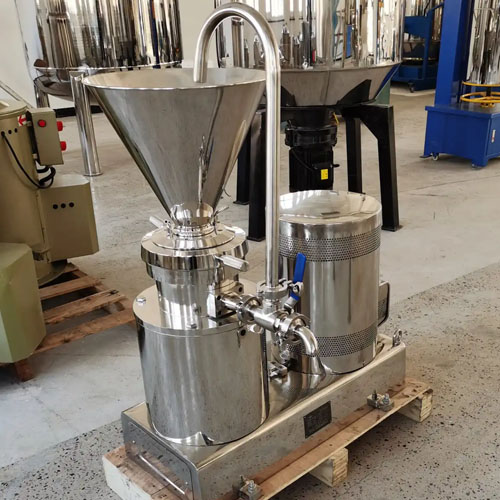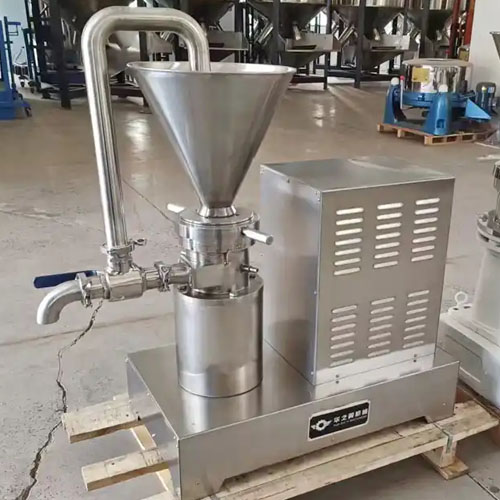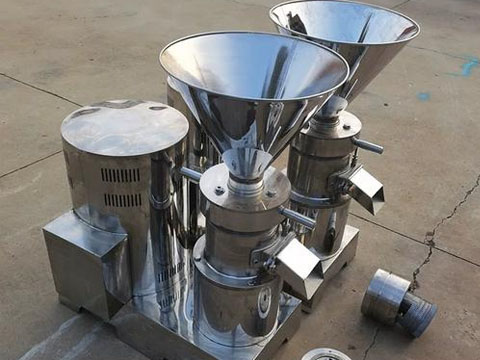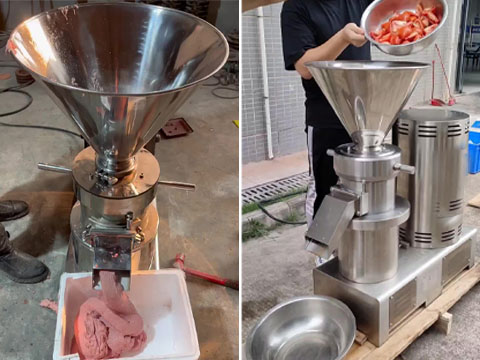How to Clean a Colloid Mill?
Colloid mills are important grinding equipment in the food, chemical, and pharmaceutical industries. They can grind a variety of materials, and residues are inevitable after grinding, making cleaning crucial. Improper cleaning can affect product purity and reduce equipment performance. This article provides detailed instructions for cleaning a colloid mill.
Preparation for Cleaning
- Safety Procedure: Completely disconnect the power! Ensure the machine is completely powered off.
- Tools: A soft brush, food-grade cleaning agent (such as dish soap), warm water, a special cleaning cloth, protective gloves, and the included wrench.
- Identify the material type: Determine whether the residue is grease, protein, or starch to determine the subsequent cleaning agent.
Cleaning Method
Colloid mills can be cleaned using two methods: CIP (Cleaning in Place) and SOP (System-of-Purpose) cleaning.
Daily Cleaning (CIP Cleaning)
- Flushing: After shutting down, pour room-temperature clean water (or a water temperature selected based on the material) into the feed inlet. Briefly start the machine and allow the water to flow through the grinding chamber, removing most residue.
- Circulating Cleaning: Add warm water and a food-grade detergent to the feed hopper and run the machine for 15-20 minutes.
- Final Rinse: Perform a final rinse with plenty of clean water until the water runs clear.
- Drying: Finally, use compressed air to blow out any remaining moisture in the pipes.
Deep Disassembly and Cleaning (SOP Cleaning)
- Disassembly: Use a special wrench to first unscrew the fixing bolts on the top of the equipment → Remove the feed hopper/funnel → Remove the end cover of the grinding chamber → Carefully remove the stator and rotor.
- Soaking and Brushing: Soak the disassembled parts in cleaning solution. Use a soft-bristled brush to carefully clean each grinding tooth gap. Do not use steel wool.
- Inspection and Rinse: Check for residue or damage, and rinse thoroughly with clean water.
- Drying: After cleaning, the parts (especially the stator, rotor, and metal end cover) must be thoroughly dried.
- Reassembly: Reassemble the parts in the reverse order of disassembly.


Cleaning Methods for Different Parts
| Part Name | Core cleaning methods (different industries) | Taboos |
| Stator/Rotor (Stainless Steel) | Food/Pharmaceutical: Wipe with a neutral detergent and clean crevices with a nylon brush, then rinse with purified water. Industrial: Soak in a neutral degreaser for 5 minutes, then clean with a soft brush and rinse with clean water. | Avoid using steel wool or sandpaper (as they may scratch the polished surface) and strong acids and alkalis (as they may corrode stainless steel). |
| Feed Hopper/Discharge Pipe | Plastic: Scrub with a soft brush and detergent, then wipe the exterior with a damp cloth. Metal: Dip in detergent, rinse, and wipe dry. | Do not use plastic in hot water above 60°C (as they may deform). Do not soak metal for extended periods (as this may prevent rust). |
| Seal/O-Ring | General Purpose: Rinse with clean water and gently wipe with a soft cloth. Food Industry: A second rinse with purified water is required. | Do not soak with detergents (as this may cause aging and leakage). Replace damaged parts immediately. |
| Equipment Housing | Wipe the surface with a damp cloth. For stubborn stains, use a small amount of detergent, then wipe dry with a dry cloth. | Do not allow moisture to penetrate the motor terminals (to prevent short circuits). Do not use a high-pressure water jet directly on the housing. |
Colloid Mill Cleaning for Different Materials
Colloid mills grind different materials and use different cleaning agents. Different residues can be treated with the right solution to achieve efficient cleaning.
- General/neutral materials (such as fruit and vegetable juices): Warm water + dishwashing liquid.
- Grease-based materials (such as nut butter): Alkaline detergent + hot water is the best choice for breaking down oil stains.
- Protein-based materials (such as dairy products and soy milk): Use warm water (<50°C). Overheating can denature and solidify the protein, so an enzymatic cleaner can be used.
- Starch-based materials: Rinse with cold or warm water to prevent gelatinization.
- High-viscosity materials (such as colloids and ointments): Soak the grinding chamber in a small amount of warm water (≤40°C) for 10-15 minutes. Then, gently scrape the inner walls with a soft plastic scraper to remove any residue. Then, clean with detergent and a soft brush. Finally, rinse with clean water.
Conclusion
Colloid mill cleaning is crucial. Mastering proper colloid mill cleaning techniques not only extends its service life but also serves as the foundation for ensuring production safety, efficiency, and product quality.
We are a professional colloid mill manufacturer. If you have any questions regarding colloid mill cleaning or other aspects of production and operating equipment, please contact us.
Our colloid mill products include split colloid mills, vertical colloid mills, and horizontal colloid mills, covering a wide range of production capacities. Feel free to contact us if you require a colloid mill.
Latest Articles
Pouch Packing Machine
Stainless Steel Spherical Evaporator
Plant Oil Extractor
Stainless Steel Floating Roof Tank
Stainless Steel Wine Cold Stabilizer Tank
Latest Products
Product Categories
Colloid Mill
- Vertical Colloid Mill
- Split Colloid Mill
- Horizontal Colloid Mill
- Commercial Peanut Butter Machine
- Tahini Machine
- Chili Sauce Grinder
- Nut Butter Grinder
Stainless Steel Tank
- Milk Cooling Tank
- Stainless Steel Mixing Tank
- Cylindrical Stainless Steel Insulated Water Tank
- Horizontal Stainless Steel Water Tank
- Vertical Stainless Steel Water Storage Tank
- Stainless Steel Reactor
- Conical Fermentation Tank
Extraction Machine
Filling Machines
Tomato sauce Production Line
Contact Us
- Mobile/Wechat: +8617637100809
- Whatsapp: +8615138685087
- Email: info02@wanzhisteel.com
- Address: 10F, Building B, Erqi Center, Erqi District, Zhengzhou City, Henan Province, China


